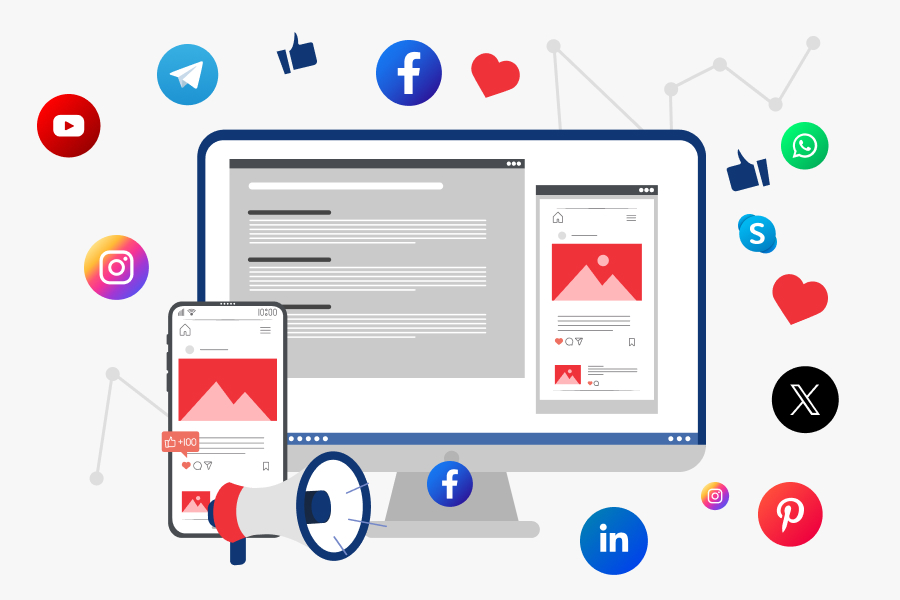Social media advertising refers to the strategies and practices businesses and organisations use to promote their products or services on various social media platforms. This approach encompasses a range of formats, targeting options, and analytics to reach and engage users effectively.
It is a form of digital marketing that involves creating and running ads on social media platforms to promote products, services, or brands. It allows businesses to reach targeted audiences where they are most active and engaged.
Difference Between Paid Advertising and Organic Engagement
While social media advertising is a strategy focused on paid promotions for immediate reach and results, organic content is centered around building relationships and community engagement over time without direct costs. Both can be complementary in a comprehensive social media strategy.
Paid Advertising
Paid social media advertising is essentially the practice of investing monetary resources to promote content on various social media platforms. By leveraging formats such as sponsored posts, display ads, and video ads, brands can ensure their messages reach a targeted audience quickly and effectively.
For example, a well-known clothing retailer might utilize Instagram sponsored posts to showcase its latest line, ensuring that stunning visuals appear in the feeds of potential customers who may not yet follow the brand. This approach allows for immediate visibility and often leads to quicker engagement and conversions compared to organic efforts.
One of the standout features of paid advertising is the precision it offers in targeting. Advertisers can finely tune their campaigns based on demographics, interests, behaviors, and even geographic locations.
This means that a local restaurant could advertise its special menu to users within a specific radius, while a global brand like Nike could target fitness enthusiasts looking for new workout gear. By tailoring messages to resonate with distinct audience segments, brands can maximize their advertising effectiveness and drive more meaningful interactions.
Organic Engagement
In contrast, organic engagement relies on the natural reach of content shared across social media platforms without any monetary investment. This method emphasizes building genuine connections and fostering a community around the brand.
Take, for instance, the way Chipotle interacts with its followers by sharing user-generated content, engaging in conversations, and even participating in trending challenges. While organic content takes time to gain traction and often requires consistent posting and interaction, it helps establish trust and authenticity, ultimately deepening customer loyalty over time.
The results generated from paid advertising are typically immediate, offering brands the kind of visibility that organic posts might struggle to achieve. When a company launches a new product, advertorial campaigns can flood feeds and stimulate interest within hours.
For instance, a smartphone company might advertise a new device through video ads that rapidly draw attention, compared to organic posts that may take longer to gain traction in users’ feeds. This efficiency is vital for time-sensitive promotions or events.
However, while paid ads offer higher visibility and quick results, organic engagement is invaluable for building a sustainable relationship with an audience. The authenticity of non-paid content fosters trust, encouraging followers to interact in a more meaningful way.
People are often more responsive to content they perceive as genuine rather than promotional. This is why brands like Netflix excel by using organic tactics—sharing memes and engaging in Twitter conversations that resonate with their audience—creating a community centered around their content.
Lastly, the ability to analyze performance metrics sets paid advertising apart from organic engagement. Advertisers can access detailed analytics that track impressions, clicks, conversions, and return on ad spend (ROAS).
For example, a beauty brand running a campaign can easily determine the success of their ads through the metrics dashboard, informing future strategies. In contrast, while organic engagement may yield qualitative insights, it often lacks the precision of paid advertising analytics, making it harder to measure direct ROI.
Types of Social Media Advertising
Social media advertising encompasses a variety of formats and strategies designed to leverage the vast reach and engagement levels of platforms like Facebook, Instagram, Twitter, LinkedIn, TikTok, and more.
1. Pay-Per-Click Advertising
One of the most common types is pay-per-click (PPC) advertising, where businesses pay a fee each time a user clicks on their ad. This method can be particularly effective for driving traffic to a website, as advertisements can be targeted based on user demographics, interests, and behaviors.
2. Sponsored Posts
Another popular format is social media sponsored posts, which are often used by brands to boost the visibility of organic content. These posts appear in users’ feeds as regular content but are marked as sponsored.
Sponsored posts allow businesses to reach a wider audience beyond their current followers, significantly increasing brand awareness and engagement. Moreover, platforms like Instagram and Facebook offer tools to create visually appealing sponsored content that resonates with users.
3. Video Advertising
Video advertising has gained immense popularity, especially on platforms like YouTube, TikTok, and Instagram. Short and engaging video ads can capture users attention quickly and convey messages in a dynamic way.
Video ads can appear in various formats, such as in-stream ads that play before or during other video content, or as standalone stories and reels that provide a brief glimpse into a brand’s offerings. The immersive nature of video content makes it a compelling option for advertisers looking to connect with their audience.
4. Influencer Marketing
Additionally, influencer marketing is a unique form of social media advertising that involves partnering with individuals who have a significant following on social media. Influencers can promote products or services through authentic content, which often leads to higher trust and engagement from their followers. This strategy taps into the influencer’s credibility, allowing brands to reach niche markets and new audiences effectively.
5. Remarketing Advertising
Finally, remarketing ads are a powerful tool for converting potential customers who have previously interacted with a brand but did not make a purchase.
These ads target users who have visited a website or engaged with a brand’s content, reminding them of products or services they showed interest in. This form of advertising can significantly enhance conversion rates as it focuses on users who are already familiar with the brand.
How Social Media Advertising Works
Social media advertising has become an integral component of digital marketing strategies for businesses of all sizes. As of 2024, social media platforms have evolved, offering sophisticated tools and features that allow brands to reach their target audience with precision and effectiveness. Below is a detailed exploration of how social media advertising works, including the key mechanisms, targeting options, and real-world examples.
1. Platform Selection
The first step in social media advertising is selecting the right platform for the target audience. Different platforms cater to distinct demographics and user behaviors.
- Facebook: With over 2.8 billion monthly active users, Facebook offers access to a broad demographic, making it ideal for brands seeking to reach a diverse audience. Businesses can utilize Facebook Ads to promote products, services, and events.
- Instagram: Known for its visual appeal, Instagram is particularly effective for lifestyle, fashion, and beauty brands. With features like Stories, Reels, and Shopping, brands can engage users creatively.
- LinkedIn: This platform is tailored for B2B marketing and is ideal for companies looking to connect with professionals, potential clients, or industry leaders. Sponsored content and InMail ads are commonly used to promote business services.
- TikTok: As one of the fastest-growing platforms, TikTok appeals primarily to Gen Z and younger Millennials. Brands can create engaging short videos to capture attention, often using influencer partnerships and challenges.
2. Ad Format and Creation
Once a platform is chosen, businesses can decide on the ad formats that best suit their marketing goals. Each social media platform offers various ad types:
- Image Ads: Simple and effective, image ads can highlight a product or service with a compelling visual. For example, a food brand might use high-quality images to showcase a new snack taste.
- Video Ads: These ads can be short clips or longer-form content designed to engage users visually and emotionally. For instance, a fitness brand could post workout tutorials or testimonials from satisfied customers.
- Carousel Ads: This format allows brands to display multiple images or videos in a single ad. For instance, a travel agency might use carousel ads to showcase different destinations, encouraging users to swipe through various options.
- Stories Ads: Full-screen ads that appear between user-generated content. For example, a fashion retailer can create time-sensitive promotions that appear as stories, prompting immediate engagement.
3. Targeting Capabilities
One of the significant benefits of social media advertising is the ability to target specific audiences based on detailed criteria:
- Demographics: Advertisers can target users by age, gender, education level, and marital status. For example, a college textbook retailer may focus its ads on young adults aged 18-24.
- Interests: Brands can reach users with particular interests or hobbies. For instance, an eco-friendly product company can target users interested in sustainability and green living.
- Behavioral Targeting: This involves targeting users based on their online behavior, such as purchase history and engagement with similar content. If a consumer regularly engages with fitness content, a sportswear brand could serve them relevant ads.
- Lookalike Audiences: Platforms like Facebook allow advertisers to create lookalike audiences, targeting users similar to their existing customers. This can expand reach while retaining effectiveness.
4. Ad Budgeting and Bidding
After setting up the ad campaign and defining the target audience, businesses need to allocate a budget and choose a bidding strategy:
- Daily or Lifetime Budgets: Advertisers can set a daily budget to control how much they spend each day or a lifetime budget for the entire duration of the campaign.
- Bidding Strategies: Social media platforms offer different bidding models, such as Cost Per Click (CPC) or Cost Per Mille (CPM), which refers to the cost per thousand impressions. Brands can choose a strategy based on their campaign goals, whether it’s maximizing clicks, impressions, or conversions.
5. Ad Placement and Scheduling
Advertisers can determine where and when their ads will appear:
- Placement Options: Social media platforms provide options for ad placements across their networks. For instance, Facebook allows ads to appear in the News Feed, Stories, Marketplace, and more.
- Scheduling: Brands can choose specific times and days to run their ads based on when their target audience is most active. For a restaurant promotion, lunchtime or early evenings might be optimal for ads.
6. Analytics and Performance Tracking
Once the ads are live, the ability to track performance becomes crucial. Most social media platforms offer robust analytics tools:
- Impressions: The number of times an ad is displayed to users.
- Clicks: The total number of times users clicked on the ad.
- Engagement: Measures interactions, including likes, shares, and comments, which can indicate the ad’s resonance with audiences.
- Conversions: The ultimate metric for many campaigns, conversions track specific actions taken by users after interacting with an ad, such as making a purchase or signing up for a newsletter.
- Return on Ad Spend (ROAS): A critical metric that indicates the revenue generated for every dollar spent on advertising.
For example, a skincare brand might analyze the performance of a Facebook ads campaign to determine which audience segment had the highest conversion rate, allowing them to refine their targeting for future campaigns.
Key Scenarios for Launching Social Media Ads
Running social media ads can be a strategic move for businesses at various stages of their growth and development. Here are several key scenarios to consider when deciding to launch a social media advertising campaign:
When You Launch a New Product or Service
If you’re introducing a new product or service, social media ads can help create buzz and generate awareness quickly. Targeted advertising can ensure that the right audience learns about your offering right away, which can be critical for a successful launch.
To Increase Brand Awareness
If you’re looking to build or boost your brand’s visibility, social media ads can reach a wide audience quickly. This is especially useful for new businesses trying to establish their presence in a competitive market or for established brands introducing new lines or rebranding.
To Drive Traffic to Your Website
When you want to increase traffic to your website—whether for e-commerce, lead generation, or simply to provide more information—social media ads can direct potential customers straight to your site. Platforms often allow you to link directly to product pages, blog articles, or landing pages.
For Specific Promotions or Sales
If you have a specific promotion, sale, or event, social media ads can effectively communicate this time-sensitive information to your target audience. They are particularly useful for seasonal sales, holiday promotions, or limited-time offers to encourage urgency and prompt conversions.
When You Want to Target a Specific Audience
Social media platforms offer sophisticated targeting options that allow you to reach specific demographics, interests, and behaviors. If your product or service has a niche audience—such as health-conscious individuals or tech enthusiasts social media ads can help you connect with those groups directly.
For Retargeting Previous Visitors
If you have an existing customer base or website visitors who did not convert, social media ads can be used for retargeting. Retargeting campaigns remind those users about your offerings, encouraging them to complete their purchases or further engage with your brand.
To Generate Leads
For businesses focusing on lead generation, social media ads can be an effective way to capture user information through forms or sign-up offers. This is particularly valuable in B2B markets, where building a list of potential clients is crucial.
When Engaging with Your Audience
If your goal is to foster community engagement, promote user interaction, or gather feedback, social media ads can facilitate this. Ads that encourage comments, shares, and discussions can enhance your connection with your audience.
To Compete with Rivals
If your competitors are actively advertising on social media and you want to maintain or improve your market position, it may be time to launch your own campaigns. Keeping your brand visible in a competitive landscape is critical for retaining customers.
To Promote Content Marketing Efforts
If you have valuable content (like blog posts, videos, or infographics) that you want to promote, social media ads can help increase visibility and drive traffic. This is particularly important for businesses relying on content marketing as a primary lead-generation tool.
When You Have a Clear Marketing Budget
Before starting social media advertising, ensure you have allocated a budget for ads. If your budget is precise and you can measure ROI effectively, running ads to optimize reach and engagement can be beneficial.
To Boost Engagement on Posts
If you have posts that are performing well organically and you want to amplify their reach, social media ads can help promote those high-performing posts to a larger audience, driving more engagement and visibility.
Top Platforms Social Media Advertising
Here are some of the top platforms that are reshaping how brands engage with consumers through advertising.
1. Facebook
Despite the rise of newer platforms, Facebook remains a dominant player in the social media advertising realm in 2024. With over 2.9 billion monthly active users, it offers unparalleled reach and a sophisticated advertising ecosystem.
Facebook’s advanced targeting capabilities allow advertisers to reach specific demographics, interests, and behaviors, making it an essential tool for marketers. The platform’s integration with Instagram further enhances its appeal, allowing brands to run cohesive campaigns across both platforms.
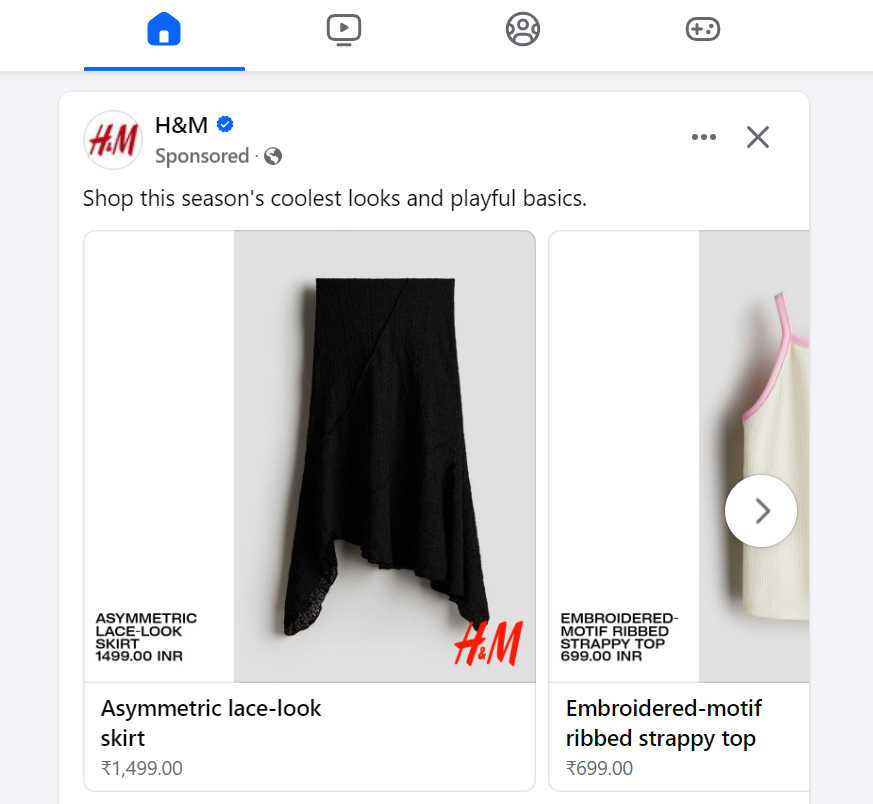
Additionally, Facebook continues to innovate with features like Reels and Stories ads, providing diverse ad formats that cater to different audience preferences.
2. Instagram
As a visually-driven platform, Instagram has solidified its importance in the social media advertising landscape, particularly for brands targeting younger demographics. In 2024, Instagram has over 1.4 billion active users, and its advertising tools are increasingly robust, enabling businesses to leverage visually appealing content to capture attention.
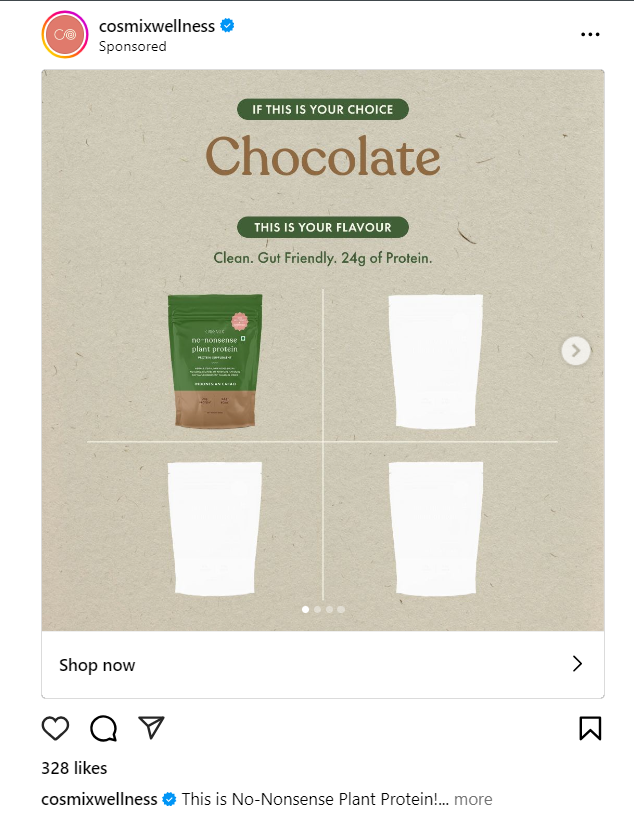
Features like Shopping on Instagram, which allows brands to tag products in posts and stories, have transformed the platform into a powerful e-commerce tool.
Moreover, Instagram’s focus on innovative content formats like Reels, IGTV, and Stories provides advertisers with dynamic ways to engage audiences, making it a favorite among brands seeking to create immersive and impactful advertising experiences.
3. TikTok
TikTok has rapidly ascended to the forefront of social media advertising, boasting over 1 billion active users in 2024. Known for its short, engaging videos, TikTok offers brands a unique platform to connect with consumers, especially Gen Z and Millennials.
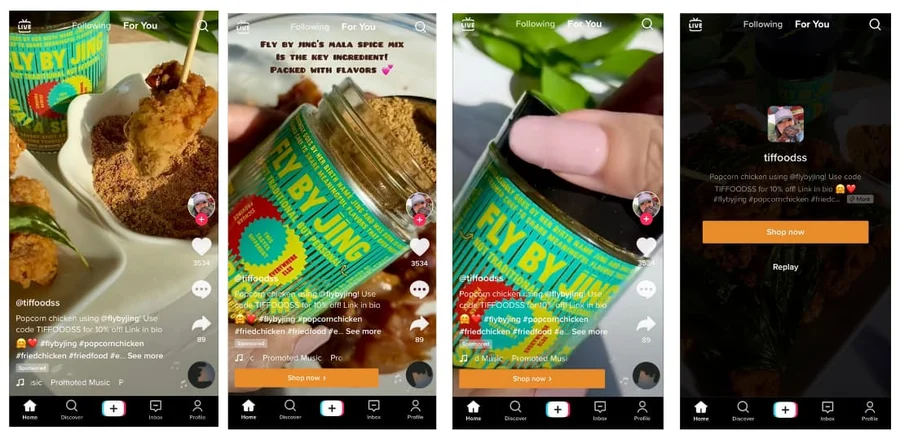
The platform’s algorithm promotes organic reach, allowing creative and entertaining ads to gain traction easily. TikTok Ads Manager has also matured, offering various ad formats such as In-Feed Ads, TopView, and Branded Hashtag Challenges that encourage user participation.
Brands are increasingly harnessing influencer marketing on TikTok, further amplifying their reach and authenticity through genuine content creation.
4. LinkedIn
For B2B advertisers, LinkedIn has established itself as the premier platform in 2024. With over 930 million members, it provides access to professionals across various industries, making it an ideal space for promoting products and services geared towards businesses.
LinkedIn’s advertising solutions, including Sponsored Content, InMail, and Dynamic Ads, enable precise targeting based on job titles, industries, and company sizes.

Promoted posts on LinkedIn are a form of sponsored content that allow businesses to boost their organic posts and reach a broader, more targeted audience. By using promoted posts, companies can increase the visibility of their content to LinkedIn users who may not already follow their page, thus expanding their reach and engagement.

Unlike traditional display or feed ads, InMail Ads provide a more intimate and direct form of communication, appearing as a private message rather than a typical advertisement. This format helps brands build one-on-one connections with their target audience and drive specific actions, such as lead generation, event registrations, or product inquiries.
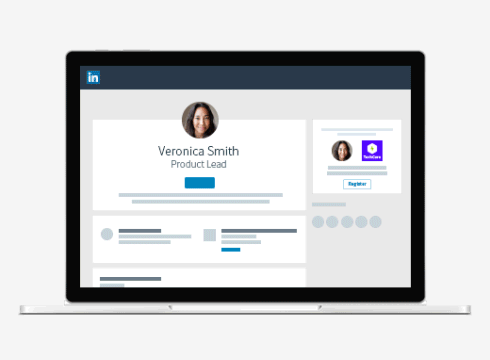
LinkedIn Dynamic Ads are personalized, automated ads that adapt content specifically for each viewer, making them a powerful tool for delivering tailored messages to LinkedIn users. These ads dynamically pull in data such as a user’s name, profile picture, or company information, creating highly personalized experiences that increase engagement and relevance.
As companies increasingly invest in content marketing and thought leadership, LinkedIn serves as an essential tool for reaching decision-makers and fostering professional relationships. The platform’s emphasis on fostering professional communities and discussions also enhances its effectiveness for brand storytelling.
5. Snapchat
While often overlooked, Snapchat continues to be a relevant player in the social media advertising landscape with around 600 million active users.
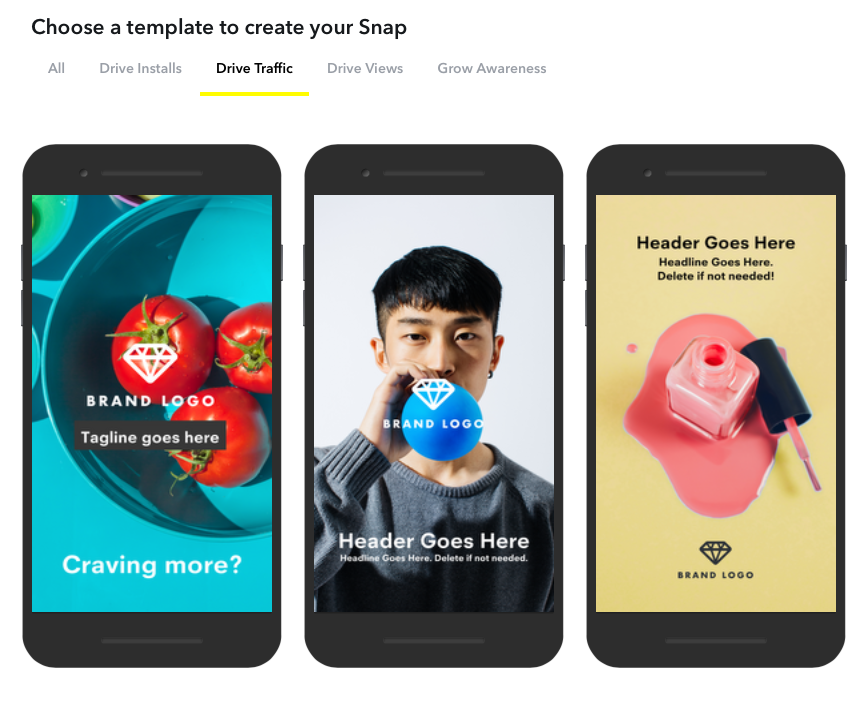
Its core demographics skew younger, primarily attracting Gen Z and Millennials, making it a valuable platform for brands targeting these age groups. Snapchat’s unique ad formats, including Snap Ads, Story Ads, and augmented reality (AR) features, allow for creative engagement strategies.
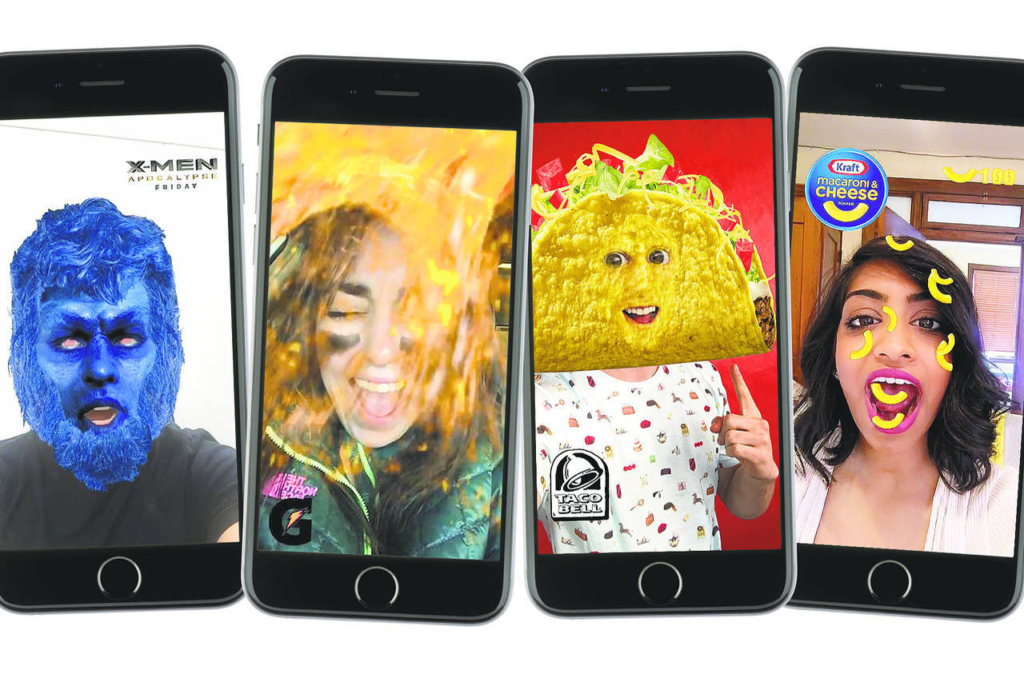
The platform’s emphasis on ephemeral content encourages immediacy and authenticity, making it an excellent choice for brands seeking to create engaging and interactive advertising experiences. As Snapchat expands its advertising capabilities and develops partnerships, it continues to carve out its niche in the crowded social media market.
6. X (Formerly Twitter)
Created in 2006, X allows users to share short messages, known as tweets, that can include text, images, videos, and links. As a platform characterized by its fast-paced and conversational nature, X offers unique opportunities for social media advertising.
Advertisers can leverage trending topics and current events to promote their products or services in real time, tapping into the conversations that are already capturing users’ attention.

For example, these are tweets that advertisers pay to place in user’s timelines. Promoted Tweets look similar to regular tweets but are amplified to reach a larger audience. They can help increase visibility and engagement for particular campaigns.
By creating a branded hashtag or participating in trending conversations, brands can increase their visibility and encourage user participation.
X supports various multimedia formats. Advertisers can use images, GIFs, and videos to create more engaging content, making their ads more appealing and impactful.
Strategies for Social Media Advertising
Social Media Advertising encompasses a variety of techniques and approaches designed to enhance brand visibility, engagement, and conversion rates on social platforms. These strategies include identifying target audiences, crafting compelling content tailored to each platform, utilizing paid advertising options, and leveraging analytics to refine campaigns.Let’s see more
1. Bidding and Targeting
Meta employs an auction system for its ads, similar to competing for valuable advertising slots on television. The platform decides which brands get their ads shown based on their relevance to users. Essentially, your ad “wins” the auction when it is positioned to reach individuals who are most likely to interact with it.
When you launch an ad campaign, you establish a timeline and budget. If you choose a lifetime budget, Meta will optimize ad delivery throughout the duration of your campaign until your allocated funds are exhausted. Alternatively, with a daily budget, you can specify the maximum amount you’re willing to spend on each ad set each day.
Targeting is another critical aspect of your ad strategy, as it dictates who will see your ads. For instance, you can create ads aimed at new customers who share characteristics with your existing clientele. Additionally, you can target specific audiences based on customer lists, website visits, and various other criteria.
2. Hyperlocal Advertising
Focus on tailoring ads not only to specific demographics but also to hyperlocal audiences. This can be particularly powerful for businesses with a physical presence. By tapping into local culture, traditions, and events, brands can build stronger relationships with niche communities.
Target users based on their geolocation and tailor your content to reflect local trends, festivals, and needs.
Partner with local influencers who have real trust and influence within their communities.
Airbnb is launching a new category called Icons, offering exceptional experiences hosted by renowned figures from music, film, TV, art, sports, and more. Icons provide a chance to immerse yourself in extraordinary, once-in-a-lifetime opportunities.
Whether it’s staying in the Up house, spending the night at the Ferrari Museum, or hanging out with Kevin Hart, Icons bring dreamlike experiences to life. It marks the introduction of the first 11 Icons on Airbnb, with additional experiences rolling out globally throughout the year.
3. Memes as a Currency of Advertising
Tap into internet culture by incorporating humor and memes into your social media ads. Memes are relatable, easily shareable, and can resonate deeply with niche audiences. However, to pull off meme advertising without appearing tone-deaf, brands must understand the context and humor relevant to their audience.
Identify trending meme formats or phrases that align with your brand identity. Adapt your product or message to fit into the meme format.
Ryanair regularly uses trending meme formats and self-deprecating humor on TikTok and Instagram to engage younger audiences. By poking fun at themselves and relatable travel frustrations, they connect on a more casual, human level.
4. Turning Data into Emotion
Instead of simply targeting your audience based on demographics or interests, dig into their emotional triggers. Use micro-moments in their day to insert yourself in a relatable, empathetic way. Craft ads that feel like they “get” what your audience is experiencing at a specific time of day, life stage, or mood.
Just think of a coffee brand that targets late-night workers. Instead of just promoting “buy our coffee,” they launch an ad campaign around 2 AM with messages like, “Up late working? So are we—grab a fresh cup and power through.” The ad becomes a relatable nod to their struggle.
5. Use Real People, Real Stories
Use real customer stories in your ads, but take it a step further by making those customers the storytellers. Let them narrate how your product or service fits into their lives, challenges, and victories. Create a sense of authenticity that makes your audience feel like they’re seeing people just like them, rather than polished actors or models.
6. Make Ads Speak to Subcultures
Hyper-personalize your ads by speaking to niche subcultures or communities with specific language, references, or cultural cues. Brands often try to go broad, but you can flip this and craft ads that say, “I see you, specifically.” Whether it’s a reference to gaming, a specific type of music, or inside jokes from certain communities, this creates intimacy.
A fashion brand might create an ad specifically for sneakerheads, not just showing the product, but weaving in sneaker culture references, insider slang, and even using real collectors in the campaign.
7. One-to-one Messaging through DMs
Move beyond traditional social ads and engage in direct conversations with users through DMs or platforms like WhatsApp. Personal messages from your brand, when done thoughtfully, can make an ad feel like a tailored recommendation from a friend. It doesn’t need to be mass communication, but micro-messaging at scale.
A skincare brand might notice that a follower commented on their post about struggling with dry skin. They could then DM the person with tips, product recommendations, and a personalized discount code. The ad here is the connection, not the pitch.
8. Storytelling with Choose-Your-Own-Adventure Ads
Let your audience choose the narrative of the ad. This makes the ad feel less scripted and more like an interactive experience. Each decision they make can change the outcome, creating a sense of personal agency within the ad space itself.
Even before its official release, the iPhone 16 Pro showcased its innovative capabilities through a unique collaboration with The Weeknd for his latest music video, “Dancing In The Flames.” Commissioned by Apple, this visually stunning piece was filmed using the iPhone 16 Pro in cinematic slow motion, highlighting the device’s advanced filming features and creative potential.
The video was shot by renowned cinematographer Erik Henriksson (@erikolovhenriksson) and directed by Anton Tammi (@antontammi), bringing a fresh artistic vision to The Weeknd’s compelling performance. The collaboration not only emphasizes the iPhone 16 Pro’s groundbreaking technology but also sets a new standard for mobile filmmaking.
With pre-orders for the iPhone 16 Pro starting on September 13, this partnership serves as a powerful testament to the device’s capabilities, generating excitement and anticipation among fans and tech enthusiasts alike.
9. Mirror Their Internal Dialogue
Craft your ad copy to mimic what your audience is thinking at that very moment. Use humor, empathy, and insight into your customer’s internal dialogue. Ads that mirror a consumer’s thoughts and feelings are incredibly powerful because they seem to read minds.
A software company targeting freelancers might run an ad that says, “Spent the last two hours organizing files instead of working? We’ve been there—let us handle that part for you.” This turns the ad into a relatable, conversational friend that offers a solution to the exact problem the customer is likely facing.
10. Ads as Personalized Invitations
Instead of asking for attention, invite users into an experience. Position your ads not as sales pitches but as personalized invitations to events, experiences, or sneak peeks. This makes your audience feel special and included, turning the ad into an exclusive opportunity rather than just another interruption.
Imagine your ads not as interruptions, but as delightful surprises like finding an extra fry at the bottom of the bag or discovering a hidden gem in a thrift store. The key is to think beyond traditional strategies i.e the power of humor, tap into the unexpected, and don’t shy away from bold experimentation. Just as trends come and go, so should your approach; be ready to pivot, play, and redefine your narrative.
